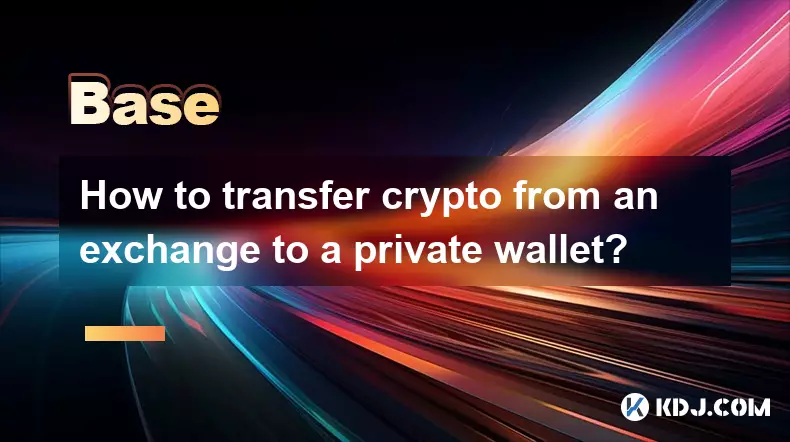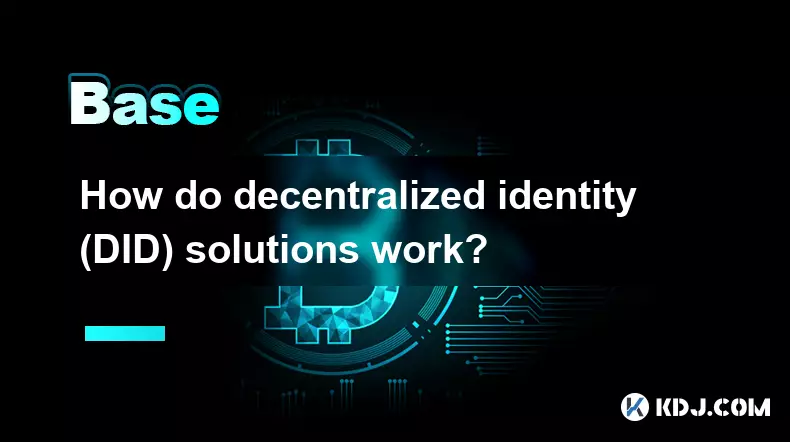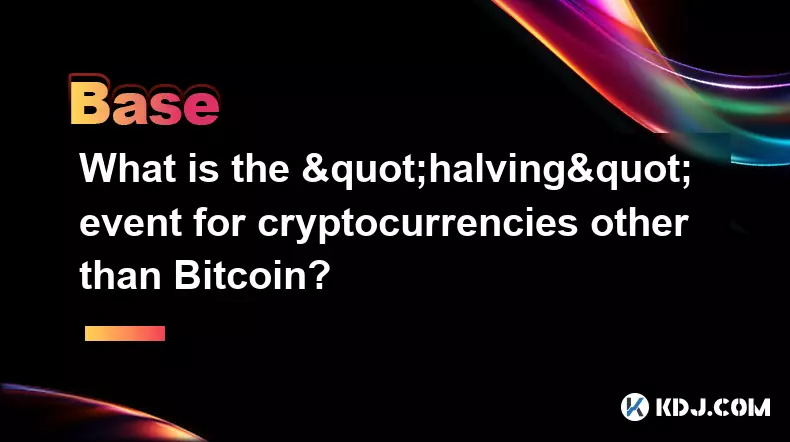-
 bitcoin
bitcoin $107015.826941 USD
-2.18% -
 ethereum
ethereum $3637.352324 USD
-5.18% -
 tether
tether $0.999831 USD
-0.02% -
 xrp
xrp $2.338078 USD
-6.23% -
 bnb
bnb $998.272150 USD
-6.97% -
 solana
solana $167.598257 USD
-10.12% -
 usd-coin
usd-coin $0.999863 USD
0.01% -
 tron
tron $0.282573 USD
-5.09% -
 dogecoin
dogecoin $0.169891 USD
-7.39% -
 cardano
cardano $0.557554 USD
-7.03% -
 hyperliquid
hyperliquid $39.914802 USD
-5.85% -
 chainlink
chainlink $15.414549 USD
-9.97% -
 bitcoin-cash
bitcoin-cash $510.361911 USD
-4.26% -
 ethena-usde
ethena-usde $0.999194 USD
-0.03% -
 stellar
stellar $0.282092 USD
-6.07%
How to transfer crypto from an exchange to a private wallet?
Always verify wallet compatibility and network type before transferring crypto to avoid irreversible fund loss.
Oct 23, 2025 at 04:18 pm

Understanding the Basics of Crypto Transfers
1. Cryptocurrency exchanges act as intermediaries where users can buy, sell, and store digital assets. However, keeping funds on an exchange exposes them to potential security risks such as hacks or platform failures. Transferring crypto from an exchange to a private wallet gives users full control over their private keys, enhancing security.
2. A private wallet refers to any non-custodial cryptocurrency storage solution—such as hardware wallets (e.g., Ledger, Trezor), software wallets (e.g., Trust Wallet, Exodus), or mobile apps—that allows individuals to manage their own private keys. This contrasts with exchange wallets, which are custodial and controlled by the platform.
3. Before initiating a transfer, ensure that the private wallet supports the specific cryptocurrency you intend to move. For example, sending Binance Coin (BNB) requires a wallet compatible with the Binance Chain or BEP-20 network.
4. Always double-check network compatibility. Sending tokens via the wrong blockchain network (e.g., sending USDT over ERC-20 instead of TRC-20) may result in permanent loss of funds if the receiving wallet does not support that network.
5. Familiarize yourself with transaction fees associated with withdrawals. Exchanges typically charge a small fee based on network congestion and token type. These fees help prioritize transactions on the blockchain.
Step-by-Step Process for Withdrawing Crypto
1. Log into your exchange account and navigate to the 'Wallet' or 'Assets' section. Locate the cryptocurrency you wish to withdraw and click on the 'Withdraw' option next to it.
2. Enter the destination address—the public address of your private wallet. This is usually a long string of alphanumeric characters or a QR code. Copy it carefully from your wallet app and paste it into the withdrawal field on the exchange.
Always send a small test amount first to confirm the address is correct and the funds arrive successfully.3. Select the appropriate blockchain network for the transfer. If you're withdrawing Ethereum (ETH), choose the Ethereum (ERC-20) network. Choosing incorrectly could lead to irreversible loss.
4. Specify the amount of cryptocurrency you want to transfer. Some exchanges allow you to enter a percentage of your balance or a fixed value. Be mindful of minimum withdrawal limits set by the platform.
5. Confirm the transaction using two-factor authentication (2FA). Most reputable exchanges require verification via SMS, email, or authenticator apps like Google Authenticator before processing withdrawals.
Security Measures During Transfer
1. Use only official links to access your exchange account. Phishing sites mimic real platforms and can steal login credentials or redirect withdrawal addresses to attacker-controlled wallets.
2. Enable all available security features on your exchange profile, including 2FA, withdrawal address whitelisting, and IP address restrictions. Whitelisting allows withdrawals only to pre-approved addresses, reducing the risk of unauthorized transfers.
Never share your private key or recovery phrase with anyone, even if prompted by what appears to be customer support.3. Monitor the blockchain explorer after initiating the transfer. Paste the transaction ID (TXID) into tools like Etherscan or Blockchain.com to track confirmation status. Most transactions require several confirmations before being considered final.
4. Avoid public Wi-Fi when conducting transfers. Unsecured networks increase the risk of man-in-the-middle attacks where malicious actors intercept sensitive data.
5. Keep records of all withdrawal details, including date, time, amount, TXID, and network used. These logs are useful for troubleshooting issues or verifying transactions during audits.
Frequently Asked Questions
What happens if I send crypto to the wrong network?Transferring tokens to a wallet that doesn't support the selected blockchain network often results in lost funds. The transaction might appear successful but will not be accessible in the destination wallet. Recovery depends on whether the service provider offers cross-network retrieval, which is rare.
How long does a crypto withdrawal typically take?Processing times vary depending on the exchange’s internal procedures and blockchain congestion. Simple transfers on fast networks like Binance Smart Chain may complete within minutes, while others on congested networks like Bitcoin or Ethereum can take hours.
Can I cancel a crypto withdrawal once initiated?No, cryptocurrency transactions are irreversible once broadcasted to the blockchain. Even if the exchange has not yet processed the request, after submission and confirmation, cancellation is generally not possible.
Why did my wallet receive less than the amount I withdrew?The difference is due to the network transaction fee deducted by the exchange during the transfer process. This fee compensates miners or validators who secure the blockchain and process your transaction.
Disclaimer:info@kdj.com
The information provided is not trading advice. kdj.com does not assume any responsibility for any investments made based on the information provided in this article. Cryptocurrencies are highly volatile and it is highly recommended that you invest with caution after thorough research!
If you believe that the content used on this website infringes your copyright, please contact us immediately (info@kdj.com) and we will delete it promptly.
- DeFi Reimagined: Decentralized Insurance Networks Meet AI
- 2025-11-05 07:05:01
- Hyperliquid (HYPE) Price Prediction: Navigating Bearish Pressure
- 2025-11-05 07:10:01
- Riding the Wave: Momentum, MMT, and Future Trends in Web3 and Beyond
- 2025-11-05 06:40:02
- Bittensor's Wild Ride: TAO Token's Volatile Moves Explained
- 2025-11-05 05:20:02
- Decoding Crypto's Wild Ride: Insights on Bitcoin, XRP, and the Future of Digital Assets
- 2025-11-05 05:30:01
- ASTER Crash, Binance & Market Chaos: Decoding Crypto's Wild Ride
- 2025-11-05 05:30:02
Related knowledge

How do decentralized identity (DID) solutions work?
Oct 14,2025 at 11:36pm
Understanding Decentralized Identity in the Blockchain Ecosystem1. Decentralized identity (DID) solutions are built on blockchain networks, allowing i...

What is the "halving" event for cryptocurrencies other than Bitcoin?
Oct 25,2025 at 12:19pm
Decentralized Exchanges Gain Momentum in 20241. Decentralized exchanges (DEXs) have seen a surge in trading volume as users prioritize control over th...

What is the difference between Near Protocol and Ethereum?
Oct 15,2025 at 08:01am
Near Protocol and Ethereum: Core Architectural Differences1. Near Protocol operates on a sharded blockchain architecture known as Nightshade, which al...

What does it mean for code to be "open source" in crypto?
Oct 12,2025 at 01:54pm
Understanding Open Source in the Cryptocurrency Ecosystem1. In the context of cryptocurrency, open source refers to software whose code is publicly ac...

What is the purpose of a "testnet"?
Oct 12,2025 at 09:01am
Understanding the Role of Testnets in Blockchain Development1. A testnet serves as a parallel version of a blockchain network, designed specifically f...

How to avoid phishing scams in crypto?
Oct 13,2025 at 06:18pm
Understanding Common Crypto Phishing Tactics1. Cybercriminals frequently use fake websites that mirror legitimate crypto exchanges or wallet platforms...

How do decentralized identity (DID) solutions work?
Oct 14,2025 at 11:36pm
Understanding Decentralized Identity in the Blockchain Ecosystem1. Decentralized identity (DID) solutions are built on blockchain networks, allowing i...

What is the "halving" event for cryptocurrencies other than Bitcoin?
Oct 25,2025 at 12:19pm
Decentralized Exchanges Gain Momentum in 20241. Decentralized exchanges (DEXs) have seen a surge in trading volume as users prioritize control over th...

What is the difference between Near Protocol and Ethereum?
Oct 15,2025 at 08:01am
Near Protocol and Ethereum: Core Architectural Differences1. Near Protocol operates on a sharded blockchain architecture known as Nightshade, which al...

What does it mean for code to be "open source" in crypto?
Oct 12,2025 at 01:54pm
Understanding Open Source in the Cryptocurrency Ecosystem1. In the context of cryptocurrency, open source refers to software whose code is publicly ac...

What is the purpose of a "testnet"?
Oct 12,2025 at 09:01am
Understanding the Role of Testnets in Blockchain Development1. A testnet serves as a parallel version of a blockchain network, designed specifically f...

How to avoid phishing scams in crypto?
Oct 13,2025 at 06:18pm
Understanding Common Crypto Phishing Tactics1. Cybercriminals frequently use fake websites that mirror legitimate crypto exchanges or wallet platforms...
See all articles










































































